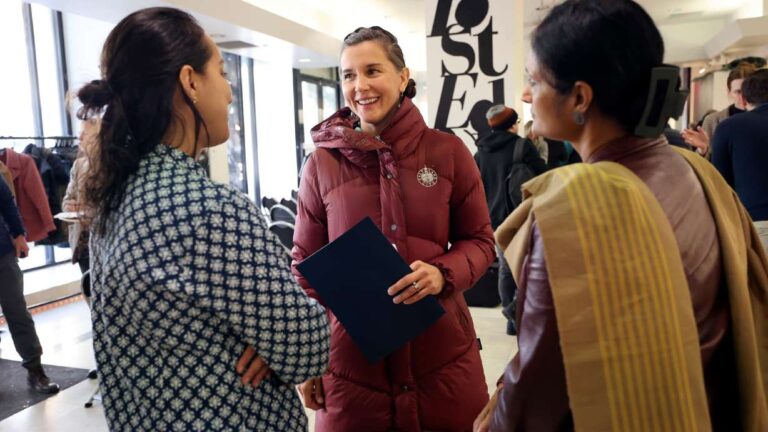
Sonali Loomba, Kaladharaa Dance owner and Indian classical dancer, left, Salt Lake City Mayor Erin Mendenhall and Srilatha Singh, Chitrakaavya Dance owner and Indian classical dancer and teacher, talk after a panel discussion about the future of art and technology on Thursday. (Kristin Murphy, Deseret News)
Estimated read time: 3-4 minutes
SALT LAKE CITY — Derek Dyer thinks people have two options when it comes to the augmented reality technology “that’s coming our way whether we like it or not.”
Dyer, executive director for the Utah Arts Alliance, said people can either embrace augmented reality technology — making it a “cool, good thing” — or they can “let it be a really bad (thing) … that’s going to make our lives worse.”
The Utah Arts Alliance sees the merging of art and technology as a beneficial thing, he said. That’s why it’s trying to get ahead of the game.
For instance, Nov. 11-12 is the group’s annual Illuminate Festival, held at the Gateway and featuring indoor and outdoor art displays that merge technology and artwork. On Nov. 11, as part of the festival, the alliance is debuting its first-ever drone show at 8 p.m. at Library Square, where 150 synchronized drones will create lit-up images in the sky. And they’ve also created several augmented reality apps, such as the SCANNOW AR app that enhances artwork placed throughout the city.
“Technology as an art is one of the most underrepresented art forms that we’ve really tried to foster here,” Dyer said. “Salt Lake City is at the precipice of a renaissance of art. … We can be a global tourism draw if we support our artists.”
Dyer’s comments came during the Art for the Future panel held Thursday at the Lost Eden Gallery in the Gateway.
Dyer, along with Salt Lake City Mayor Erin Mendenhall, Weber State University art professor María del Mar González-González and JOYMOB founder Bahaa Chmait, discussed the intersection of art, technology and the city.
Mendenhall said she’s been happy to support arts and community during her time as mayor — in fact, three full-time positions were added to the Arts Council during the last budget, she said, the first Arts Council staffing increase in a decade.
Mendenhall said the Arts Council supports community arts programming through everything from festivals to grant programs, “and we are so proud to do that with our taxpayer dollars. … (Art) is good for the soul and the economy and it creates an authentic culture.”
Creating authentic experiences is what Chmait’s organization is all about. JOYMOB focuses on creating human connection through events like dance parties in streets and writing “love letters” that are left in public places.
Chmait said growing up with Lebanese parents in a “white Ukrainian Christian town” in Canada came with some challenges, such as his family wanting him to live by old-world values in a community where he was surrounded by the new world.
But those challenges gave him “the stepping stone to be a programmer, someone who programs our culture and my community,” he said. “I think that we have a real opportunity here in Salt Lake City, especially with all the economic development (and) the new infrastructure … to truly shape Salt Lake City for future generations.”
“We’re looking to reinvent the way we think about public spaces and gathering,” he said. “We create brave spaces for people to show up with their authentic selves.”
And González-González emphasized the importance of supporting diverse artwork.
She teaches Latin American art history, she said, and Latin American artists are “woefully underrepresented” within the art community. That’s why, in her upcoming partnership with the Utah Museum of Contemporary Art, she’s focusing on widening representation within predominantly white spaces, she said.
“I want us to be thinking about more nuanced and complex ways of self-representation,” she said.